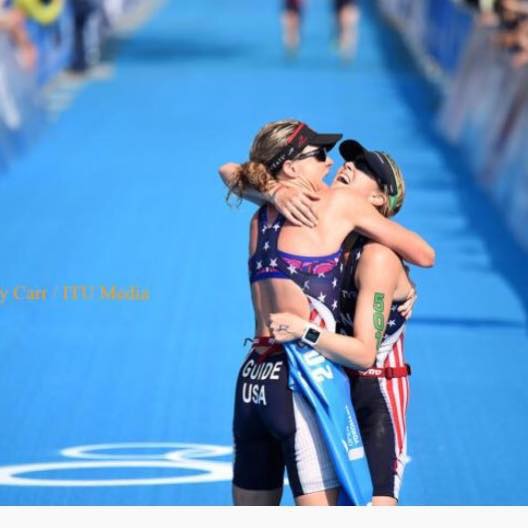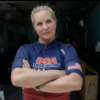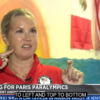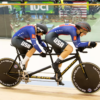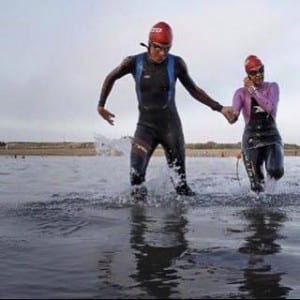 I have been blessed this year to have former ITU pro, Ironman Kona Masters Champion, and USA Triathlon Master’s Athlete of the Year Susanne Davis, a mom of two and a wife, be my race guide. We have traveled the country together for camps, races, training sessions and media obligations. She put going back to Kona to the World Championships on HOLD for me this year to allow me to qualify and go to the Rio Paralympic Games. Next year she will be back on her training plan for Kona, and with her husband’s new job, less likely to be able to drop everything and race with me. Finding Susanne as a guide took months of phone calls, emails, and research amongst top female athletes. I will never find another Susanne, as she has pulled my best performances out of me ever thanks to her depth of knowledge and experience as a coach and a pro who has been racing at the elite level for more than 20 years. So what does being an ‘Elite Guide’ look like?
I have been blessed this year to have former ITU pro, Ironman Kona Masters Champion, and USA Triathlon Master’s Athlete of the Year Susanne Davis, a mom of two and a wife, be my race guide. We have traveled the country together for camps, races, training sessions and media obligations. She put going back to Kona to the World Championships on HOLD for me this year to allow me to qualify and go to the Rio Paralympic Games. Next year she will be back on her training plan for Kona, and with her husband’s new job, less likely to be able to drop everything and race with me. Finding Susanne as a guide took months of phone calls, emails, and research amongst top female athletes. I will never find another Susanne, as she has pulled my best performances out of me ever thanks to her depth of knowledge and experience as a coach and a pro who has been racing at the elite level for more than 20 years. So what does being an ‘Elite Guide’ look like?
Want to travel the world and be someone’s eyes? While the task of guiding a blind athlete may be emotionally fulfilling for those that are generous enough to do so, it can be a daunting time commitment once that athlete rises to the top of their sport.
It’s hard to believe that only three short years ago an amazing woman by the name of Caroline Gaynor, offered to guide me for my very first race. She is known as the ‘guide’s guide’, happily offering her race guiding services to visually impaired athletes of all distances from sprints to Ironman, and training and recruiting new guides along the way. These days there are dozens of wonderful organizations throughout the world pairing sighted running, biking, swimming, rowing, ski, and hiking guides. Achilles International may be the largest globally, Team Red White and Blue thanks to their former triathlon director has been an integral guide resource, Challenged Athlete’s Foundation, the Blind Stoker’s Club, Ski for Light, and United In Stride (a guide database online) all have led the charge to get people with vision loss more physically active, able to do so safely with a sighted person by their side.
I now have dozens of friends all over the country thanks to being guided. A simple Facebook post in a visually impaired running group, a log-in to United in Stride, and I have a guide for whatever paced workout is on my coach’s schedule that week when traveling. Local triathlon and running clubs have been a valuable resource. Four of my local female guides and all of my local guides were all met through my triathlon club or at my YMCA at the pool. I get a ton out of these relationships. Not only do they provide sight and a voice of safety while training or racing, but they have become incredibly helpful for the daily life of a blind athlete.
Transportation is the single biggest obstacle to persons with vision loss. After a workout, a great amount of times my guides have driven to a doctor’s appointment, dropped my bike off for repairs, taken me grocery shopping, dropped me at the train. With all of this generosity they have shown me, I often wonder; what’s in it for them?
When guiding for local races, it’s the camaraderie, the sense of accomplishment, and the sense of knowing you are enabling someone to enjoy your sport who otherwise wouldn’t be able to do it without your help. You might sacrifice some of your own weekend workouts or juggle kids’ schedules to fit in a local race. Maybe you work full-time in NYC. Your kids have camp, soccer, band practice. Your husband travels for business. So what happens when the athlete advances to an elite level?
After racing internationally for two seasons, I have met dozens of elite blind athletes in all types of sports. The common thread? Their guides are full-time guides. As in “No other job”. It was baffling to me. How is this possible? Then I realized. It’s necessary. The guides headed to Rio with their athletes this September all are full time professional athletes, personal trainers and coaches with no exception. Some even live with their athletes. When I expressed the desire to live and train full time at the Olympic Training Center in either Colorado or Chula Vista, USA Paratriathlon clearly expressed to me that they require guides to live there as well. The expectation that a guide/ athlete team to train together full time is indicated. Team USA Camps require we now bring our race guides to these camps rather than a backup guide or temporary guide. You must be a team.
The British system of Paratriathlon has it right, or close to it. They pay their guide athletes a monthly living stipend in order to afford food, sports medicine and training and travel expenses, just like the athlete. Because they ARE half of the important equation. Here in the USA, the burden of expense falls on the blind athlete to acquire and train and help transport their guide to training sessions. Our race related travel is mostly covered for ourselves and our guides. If we do not make the podium at a race, our reimbursement is less, and we therefore cover more out of our own pockets.
We do so for our guides out of gratitude for the time they commit to training, racing and being there for us. Being a guide doesn’t just start when the gun goes off or end at the finish line. Elite level racing guides are likely former or existing pros or coaches. They help the blind athlete with sessions in training. They impart their vast experience and play sports psychologist. They help navigate a confusing set of rules and regulations of the ITU racing circuit. They maintain their own level of fitness at a 20% fitter level, and monitor injuries closely that can affect their athlete’s performance. They schedule their races and recovery around the athlete’s ever-changing race calendar. They drop everything to go to faraway races in Japan, the Netherlands, Canada with little rest in less-than-luxurious accommodations. They work in conjunction with a barrage of coaches, sports psychologists, dieticians, bike-fitters, strength training specialists and more to help their athlete be the best they can be on race day. They are available for phone, TV and radio interviews at the drop of a hat. They make appearances at the non-profits who support them and their athlete. They post on social media to attract and retain potential and current sponsorships. They host and attend fundraisers for their athlete, helping to fund a dream of making it to the top of their sport. And with the exception of Great Britain? They do it all for free.
The sad thing? Here in the USA, and also in Great Britain (although in the UK the guides are paid team members), Guides are considered ‘property’ of the team and not the athlete. Although the athlete may spend thousands, even tens of thousands on equipment, travel and hundreds of hours of training with their guides, the federation reserves the right to take these guides and reassign them to another athlete if they feel it’s a better or more suitable match. I’ve seen it happen twice to friends of mine, and more recently had it happen to me. The guides become more than your eyes. We form close friendships while staying in their homes, meeting their families, and sharing the common bond of group suffering together during tough workouts and grueling races.
My solution to all of this? Because guides are so valuable at the elite level- they are highly skilled, extremely fit former or existing pros who are also likely coaches, they should be paid. Handsomely. In some ways I think even more so than the athlete. I mean, what’s IN IT for them? There’s none of the glory; guides rarely get recognized during major races or in the media, despite the fact that they just ran, biked, and swam the same distance as the athlete, all while keeping someone safe and communicating to them non-stop. For the USA and other countries to attract the best race guides and to develop a team of elite level guides who are ready at the drop of a hat to attend a camp, a race, a training session, or media interviews, they need to pay them. It is a huge sacrifice. Elite guides need to either be single, fast and young without their own set of immediate professional athletic goals, a current pro or coach with a vast home support network to take care of their families, or a retired pro with older kids and a job that allows them to work from the road or be extremely part time. Know anyone who fits that bill? Email me at Amy@amydixonusa.com
And finally? THANK YOU to the guides that have tirelessly helped me climb the ranks to the top of my chosen sport. Each of you is a selfless, incredibly wonderful person who has made me better in every way. From our friendship to our athleticism that has grown with time. I could NOT have done this without your sacrifice and love and generosity. Bless each and every one of you.
